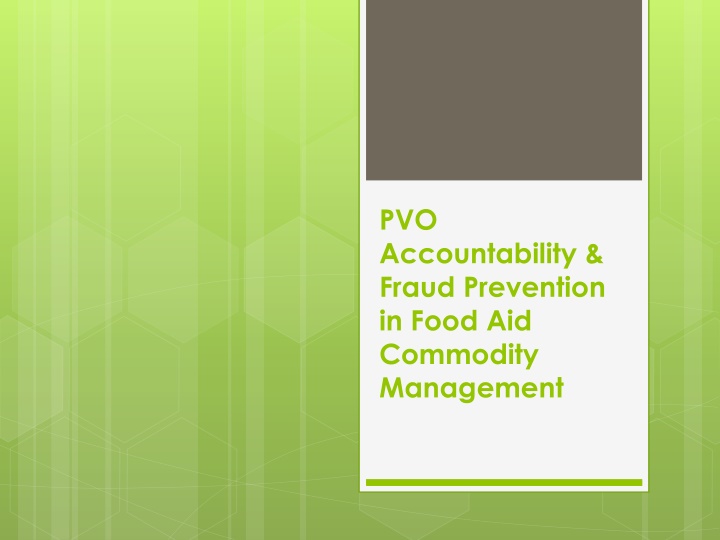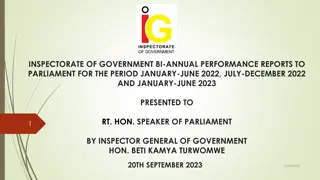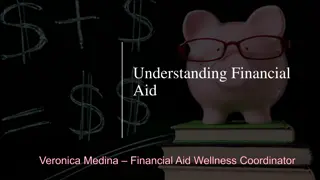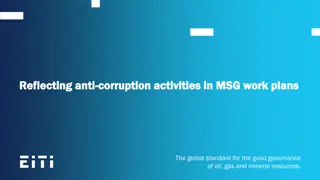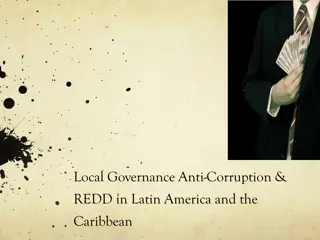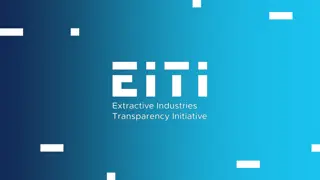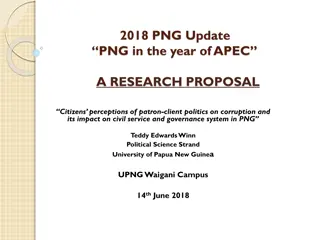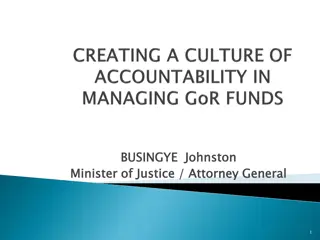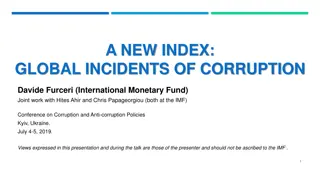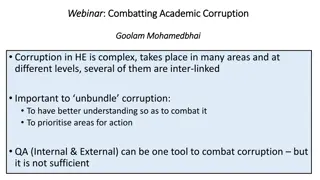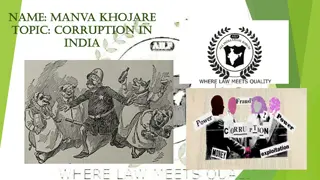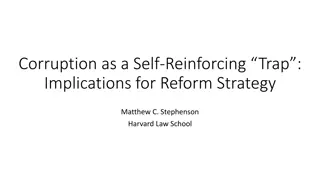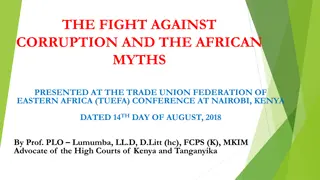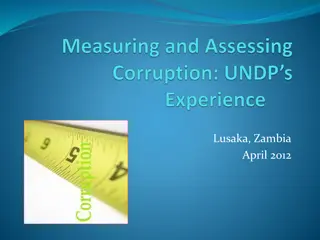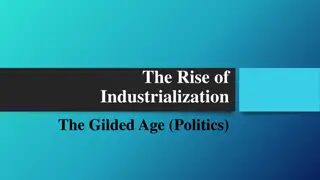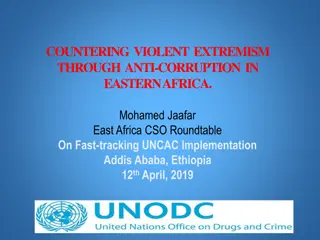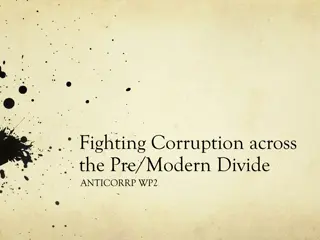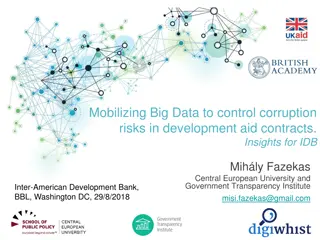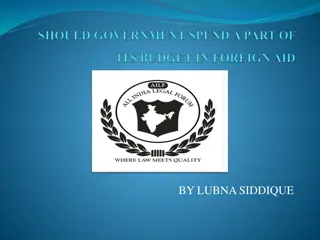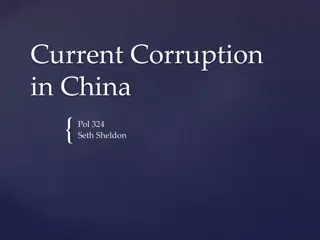Corruption and Accountability in Food Aid Management
Corruption in humanitarian aid, particularly in the management of food aid commodities, deprives the most vulnerable of essential resources, hindering the noble goal of saving lives during crises. Examples from the Liberia-Sierra Leone refugee crisis shed light on the rampant corruption, where beneficiaries were exploited through sexual favors. The detrimental effects of corruption on humanitarian assistance underscore the need for rigorous accountability measures to prevent fraud and ensure aid reaches those in need.
Download Presentation

Please find below an Image/Link to download the presentation.
The content on the website is provided AS IS for your information and personal use only. It may not be sold, licensed, or shared on other websites without obtaining consent from the author.If you encounter any issues during the download, it is possible that the publisher has removed the file from their server.
You are allowed to download the files provided on this website for personal or commercial use, subject to the condition that they are used lawfully. All files are the property of their respective owners.
The content on the website is provided AS IS for your information and personal use only. It may not be sold, licensed, or shared on other websites without obtaining consent from the author.
E N D
Presentation Transcript
PVO Accountability & Fraud Prevention in Food Aid Commodity Management
Corruption in Humanitarian Assistance During the Liberia - Sierra Leone refugee crisis 2001-2002, there were numerous examples of corruption in the humanitarian assistance On different occasion beneficiaries have been told that their names were not in the list, and the computer swallowed their cards, unless they gave sexual favor I sleep mostly with NGO workers: I have to eat and feed my child, reported a Liberian refugee during the UNHCR-Save the Children investigation in Guinea 2
Effect of Corruption Corruption in humanitarian aid deprives the most vulnerable people of essential life-saving resources Humanitarian assistance aims to save lives and alleviate the suffering of people in times of crisis Yet these noble ambitions do not immunize humanitarian agencies and their activities (emergency responses) from corrupt abuse
What is Corruption? the abuse of entrusted power for private gain - Transparency International
Corruption Risk Mapping (Developed by ODI & MANGO) Group discussion (5 mts) & rate your project as: Corruption Less Likely or Corruption More Likely by using the Corruption Risk Mapping tool
Implementation of Food Assistance Program: An OIG Lessons learned report Major Systemic Issues Management & Oversight Controls Inability to obtain Appropriate data Diversion of funds and other illicit acts Recovering losses once they are discovered
Where does Corruption Start?? Proposal Stage? Registration of Beneficiary? Internal Transportation of Commodity? Storage of Commodity? Distribution of Commodity?
Preventing Corruption in Humanitarian Operations The Handbook of Good Practices Created by Transparency International and a Consortium of International Humanitarian NGOs
How is the Book Structured The book has been divided into 3 major parts: Institutional Policies and guidelines (Section I) Includes overall discussion on Risk Analysis, Management Leadership, Emergency Preparedness, Internal controls and quality assurance, transparency and accountability, dealing with the external environment, building a comprehensive anti corruption strategy Corruption in Program Support Functions (Section II) Procurement, transport, Asset Management, Human Resource and Finance Corruption in the program cycle(Section III) Needs Assessment, Partners and Local Intermediaries, Targeting and registering Beneficiaries, Distribution and Post Distribution, Program Monitoring and Evaluation, Commodities
Section III Red Flags Issues with Partners or local Intermediaries: Potential partners lacking physical offices or clear governance structures Partners with staff who appear to come from the same family Partners unwilling to be fully transparent about activities, staff and experience Unexplained fees or payments by partners to third parties Partner activities with expenses higher than market prices Reports of sexual exploitation or extortion of staff or beneficiaries
Section III Red Flags Targeting and registering beneficiaries: Criteria that are too general or vague Criteria not verifiable Registration cards without means of identification Beneficiaries appearing well dressed and fed than expected Altered and fake registration cards or identity documents
Section III Red Flags Distribution and Post Distribution: Large Quantities of relief goods on sale in local markets Altered or rewritten distribution records Discrepancies between cash entitlements in the needs assessments and disbursements. Similar signatures in distribution list Fingerprints where people are mostly literate Perfect distribution list never mentioning implementation problems Inconsistent Narrative and Financial reports
Section III Red Flags Commodities: Packages appearing tampered with Food packages arriving underweight Large quantities of relief food on sale in local markets Altered or rewritten distribution records Beneficiaries still malnourished after distribution Staff living above their means
Section II Red Flags Transport & Asset Management: Shipments arriving with lower weight, or fewer or poorer quality than at origin Packages tampered with Unusually high mileage on the delivery trucks Relief goods for sale at the local markets Documents altered without reason and not original Staff accessing Storage facility at odd hours Variances in cost per km between different vehicles of similar type and age
Section III Red Flags Resource Allocation: Assessment staff pushing for a particular region or group Assessees or interviewees resisting your efforts to consult with other resources Beneficiary numbers close to or exceeding the total population Local elites reluctance to allow independent verification of needs assessment
16 Dilemmas & Trade-Offs There is no magic formula! Too many vs. too few controls Urgency/need for speed vs. Prudence Pressure to spend vs. getting things right Transparency vs. staff and beneficiary security Information sharing and joint action vs. legal issues
